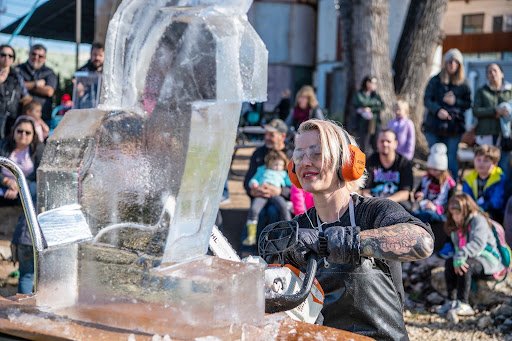Ice is weird and wonderful. Just ask a scientist—or an artist, like Sean Leahy. Armed with a chainsaw, he’ll be carving a block of ice into a shimmering sculpture at the Science Mill’s Snow Day on Saturday, January 15, 2022.
What makes ice so weird? Unlike most compounds, water’s solid state is actually less dense than its liquid state. You see this strange trait in action when ice cubes float in a glass of water. Liquids get denser as they cool; their molecules slow and move closer together. That’s true of water, too, but only up to a point—39.2° F (4° C), to be specific. As water reaches the freezing state, the hydrogens in its H20 molecules form a hexagon-shaped network of bonds with open spaces between them. This causes water to expand in volume as it freezes and makes ice less dense. The hydrogen bonds are also the start of snowflakes’ six-sided shapes.
Molecules in liquid water (left) vs. frozen water (right), when hydrogen bonds form
As an ice sculptor, Sean has to understand those changing hydrogen bonds to predict how the ice he’s carving will behave. Start carving too soon and CRACK! An ice block can go into thermal shock when its surface warms faster than its center, causing parts to contract while others expand. Ice blocks typically need to rest for a few hours until they’ve adjusted to the surrounding air temperature. The “texture” of an ice block goes from soft to hard and back to soft as it warms. Carving also warms up the ice, so once a sculptor starts it’s a slow-motion race against temperature and time.
For big pieces, sculptors use chainsaws to complete about 60-70% of the carving. Then they smooth out shapes, add details and create textures with a combination of hand chisels and power tools, such as die grinders and drill bits in unique shapes. Sculptors can even weld ice blocks together to make bigger pieces (or repair a break). Depending on the temperature, they either heat the surfaces with an aluminum heating plate, carve channels for water, or add slush or dry ice to fuse the ice together.
Sculptor Griffin Ramsey uses a chainsaw to shape a block of ice at Snow Day 2020
The temporary nature of ice is what appeals to Sean as an artist. “I find satisfaction in the process of creation and appreciate the life and changes that occur as the pieces melt.” Sean followed his childhood passion for drawing to earn a B.A. in Studio Art at Webster University. After taking a job at a local ice sculpting company, he discovered a new passion. Sean is now an award-winning Professional Carver and Ice Educator certified by the National Ice Carving Association, with his own ice sculpting company in San Marcos, TX.
See Sean in action and make your own frozen creations with 30 tons of real snow at Snow Day 2022—tickets available now (LEARN MORE)
MORE TO EXPLORE
Check out Sean’s latest creations for Full Spectrum Ice on Instagram
Using everything from hand saws to chain saws to computer-guided lasers, ice sculptor Shintaro Okamoto demonstrates techniques at 10 levels of difficulty (VIDEO)
A scientist and an ice sculptor explain what fascinates them about frozen water (VIDEO)
“Weird, hot, black ice?” Ice actually comes in over a dozen phases—some in nature, some produced in labs—including a recently created superionic ice that is modeled on planets like Neptune.


